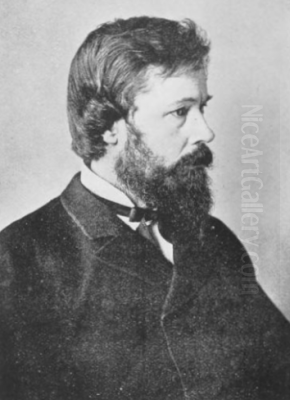
John Joseph Enneking stands as a significant figure in American art history, particularly noted for his contributions to Impressionism and his evocative depictions of the New England landscape. Active during a transformative period for American art, Enneking forged a unique path, blending European influences with a distinctly American sensibility. His life, marked by early challenges, wartime service, dedicated study, and prolific creation, offers a compelling narrative of artistic development and perseverance. His work continues to be celebrated for its vibrant color, expressive brushwork, and deep connection to the natural world.
Early Life and Artistic Awakening
John Joseph Enneking was born on October 4, 1841, in Minster, Ohio. His parents were of German descent, and his early life unfolded on the family farm. Tragedy struck early when his father passed away, leaving his upbringing primarily to his mother. From a young age, Enneking displayed a burgeoning interest in art, a passion reportedly encouraged by his mother, even if met with initial disapproval from his father. This early inclination towards visual expression set the stage for a lifelong dedication to painting.
His formal artistic education began in 1858 at Mount St. Mary's College in Cincinnati, Ohio. Here, he started to hone his skills in drawing and painting. However, like many young men of his generation, his studies were interrupted by the outbreak of the American Civil War. Enneking enlisted in the Union Army, serving bravely but ultimately sustaining serious injuries during combat. This wartime experience marked a significant interruption in his artistic pursuits.
Formative Years: Boston and European Sojourns
Following his recovery from war wounds, Enneking sought a new direction. He initially explored other avenues, including a brief period involved in the manufacture of tinware, a venture he reportedly abandoned due to issues with his eyesight. Ultimately, his passion for art drew him back. He moved first to New York and then, around 1865, settled in Boston, a city that would become his long-term home and the center of his artistic career.
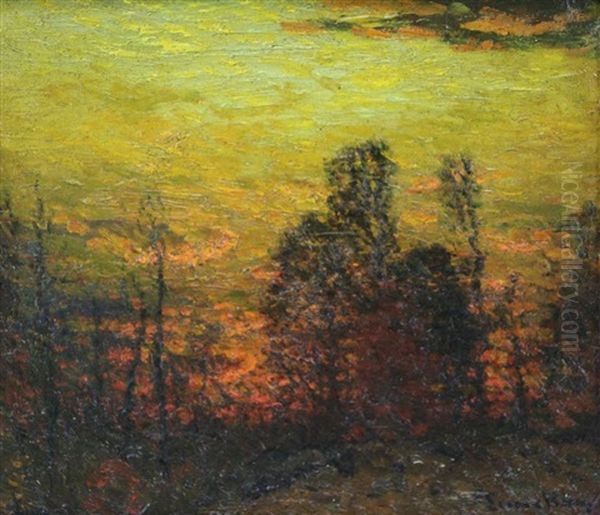
In Boston, Enneking immersed himself in the local art scene while continuing his education. He studied lithography and drawing, skills that likely broadened his understanding of composition and line. He took advantage of night school classes to further develop his painting techniques. Boston provided a stimulating environment, but Enneking, like many ambitious American artists of his time, recognized the importance of European study to fully develop his craft.
The 1870s marked a crucial period of international study for Enneking. He traveled to Europe, seeking instruction from leading artists and immersing himself in the continent's rich artistic traditions. His first major stop was Munich, where he enrolled at the prestigious Royal Academy of Fine Arts. The Munich school was known for its dark palettes, vigorous brushwork, and emphasis on realism, elements that would subtly inform Enneking's later work, particularly his handling of shadow and form, showing an influence from Baroque chiaroscuro.
From Munich, Enneking moved to Paris, the undisputed center of the art world at the time. This period proved transformative. He studied under the respected academic painter Léon Bonnat, known for his portraiture and historical scenes. Perhaps more significantly, he spent time with artists associated with the Barbizon School, notably Charles Daubigny. Daubigny, along with figures like Jean-Baptiste-Camille Corot and Jean-François Millet, championed landscape painting executed outdoors (en plein air) with an emphasis on capturing atmosphere and the effects of light, a philosophy that resonated deeply with Enneking.
Crucially, his time in Paris coincided with the rise of Impressionism. Enneking encountered the revolutionary works of Claude Monet and Camille Pissarro. He absorbed their interest in capturing fleeting moments, their use of broken brushwork, and their brighter, more vibrant palettes designed to convey the transient effects of light and color. Some accounts suggest he may have even painted alongside Monet, possibly in the vicinity of Argenteuil or even later visiting Giverny, absorbing the Impressionist ethos firsthand. He also reportedly met Pierre-Auguste Renoir during this period. He also spent time painting in Venice, further expanding his visual and technical repertoire.
The Boston Years: Style and Subject
Returning to Boston in the mid-1870s, Enneking brought back a wealth of experience and a newly refined artistic vision. He established a studio and quickly became a prominent figure in the city's burgeoning art community. His European training, combined with his innate talent and dedication, set him apart. He held his first significant solo exhibition in Boston in 1876, an event that helped solidify his reputation as a leading landscape painter.
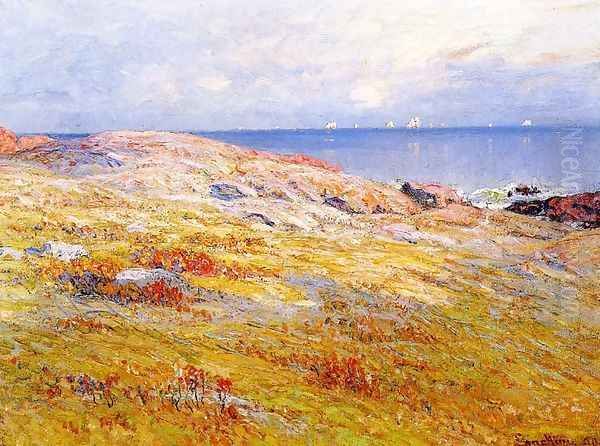
Enneking's mature style is often characterized as a unique synthesis of the various influences he absorbed. While deeply impacted by French Impressionism, particularly in his use of color and light to capture specific times of day and atmospheric conditions, he never fully abandoned the darker, more tonal qualities associated with the Munich School and the Barbizon tradition. His work often displays a richer, deeper palette than that of many French Impressionists, retaining a sense of underlying structure and form.
He is sometimes associated with the Boston School of painters, a group active in the late 19th and early 20th centuries known for figurative work and impressionistic landscapes, although Enneking maintained a distinct artistic identity. His style also shows affinities with American Tonalism, championed by artists like George Inness and Dwight Tryon, particularly in his moody, atmospheric twilight scenes. Yet, the vibrancy and broken brushwork in many of his pieces clearly align him with American Impressionism, alongside contemporaries like Childe Hassam, Willard Metcalf, and Frank W. Benson, though his approach remained uniquely his own.
Enneking became renowned for his depictions of the New England landscape, which he painted with intimacy and affection. He was particularly drawn to the woods, streams, and hills surrounding Boston, especially areas like Hyde Park (where he lived), Milton, and the North Shore. He developed a particular fondness for capturing the transitional moments of the day – sunrise and, most famously, sunset or twilight. His "November Twilight" scenes became something of a signature, evoking the melancholic beauty of late autumn light filtering through bare trees. He was also celebrated for his spring landscapes, capturing the delicate blossoms and emerging greenery with a fresh, vibrant palette.
A Network of Artists and Professional Life
Throughout his career, Enneking was an active participant in the Boston art world. He associated with fellow artists and exhibited his work regularly. He was connected with organizations like the Boston Art Club and exhibited at venues such as Gould's Galleria of Fine Arts, described as an artists' cooperative. His circle included prominent Boston painters like Joseph DeCamp and Frank W. Benson, who were also key figures in the Boston School and later members of "The Ten" American Painters.
While influenced by European masters like Daubigny, Corot, Monet, and Pissarro, and working alongside American contemporaries, Enneking cultivated a sense of artistic independence. Some sources note that he consciously avoided aligning himself too closely with any specific artistic "school" or movement, preferring to follow his own path. This independence is reflected in the unique blend of styles found in his work.
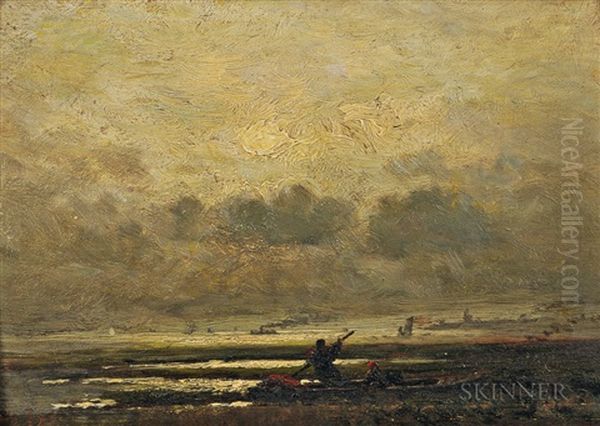
Beyond his easel painting, Enneking engaged in other professional activities. He worked as an illustrator, contributing drawings to publications like Harper's Weekly, demonstrating his skill in graphic arts. He also supplemented his income by teaching private art lessons, sharing his knowledge and experience with aspiring artists in the Boston area. His success allowed him to maintain a thriving studio and support his family through his art.
His reputation extended beyond Boston. Enneking exhibited his work in other major American cities, including New York and Chicago, participating in important national exhibitions like those at the National Academy of Design and the Pennsylvania Academy of the Fine Arts. He received numerous awards and honors throughout his career, cementing his status as a nationally recognized artist.
Signature Works
John Joseph Enneking's prolific output includes many celebrated landscapes. While specific titles varied and he often revisited favorite locations, certain themes and subjects are representative of his oeuvre:
Twilight Scenes: Perhaps his most iconic works are his depictions of late afternoon, sunset, and twilight, often set in wooded landscapes. These paintings, frequently titled November Twilight, Sunset, or similar variations, masterfully capture the low, warm light filtering through trees, the long shadows, and the evocative, often melancholic mood of the day's end. He used rich colors and expressive brushwork to convey the atmospheric effects.
Spot Pond, Melrose: This location, north of Boston, was a recurring subject for Enneking. He painted Spot Pond in various seasons and times of day, exploring the changing light and reflections on the water. These works often showcase his Impressionist handling of light and color within a recognizable local setting.
Spring Landscapes: Enneking was also known for his vibrant depictions of spring. Paintings capturing apple blossoms, flowering meadows, and the fresh greens of early spring demonstrate the brighter side of his palette and his ability to convey nature's renewal.
New England Countryside: Works like Morning on the Marshes and Autumn Vista exemplify his broader engagement with the New England landscape. These paintings capture the specific character of the region – its rolling hills, marshes, forests, and farms – often imbued with a sense of atmosphere and painterly texture. His travels within New England, including trips to Maine and New Hampshire, provided ample subject matter.
His paintings are characterized by their textural quality, often featuring thickly applied paint (impasto) and visible brushstrokes that contribute to the overall vibrancy and immediacy of the scene. He successfully balanced the Impressionist concern for capturing fleeting light with a Barbizon-inspired feeling for nature's enduring presence.
Civic Spirit and Artistic Independence
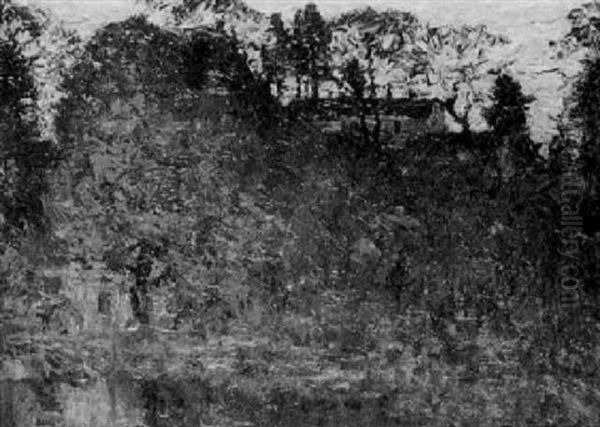
Enneking was not only dedicated to his art but also actively involved in his community. He served as a Parks Commissioner for the city of Boston, demonstrating a commitment to preserving natural spaces for public enjoyment. This role connected directly to his artistic interests, as he advocated for the development and protection of the very landscapes he loved to paint. His involvement coincided with the creation of Boston's famed "Emerald Necklace" park system, designed by Frederick Law Olmsted.
His civic engagement extended to his personal life in Hyde Park, the Boston neighborhood where he resided for many years. His contributions to the community and his advocacy for natural preservation were later commemorated by the naming of Enneking Parkway in the Stony Brook Reservation area, a lasting tribute to his local impact.
Despite his integration into the Boston art scene and his connections with fellow artists both in America and Europe, Enneking maintained a notable degree of independence. As mentioned earlier, reports suggest he resisted being strictly categorized or joining formal art groups or movements. This desire for autonomy allowed him the freedom to synthesize diverse influences – from the dark tones of Munich to the bright light of Impressionism – into a style that was recognizably his own, rather than adhering rigidly to the dictates of a particular school.
Later Life, Legacy, and Rediscovery
Enneking married Mary Katharine Elliott (often cited as Katharine Mary Etten) in 1874. The couple remained together until her death in 1914. His later years continued to be productive artistically. In 1915, a year before his death, the Boston art community organized a large testimonial dinner in his honor at the Copley Plaza Hotel, attended by over a thousand guests, signifying the high esteem in which he was held. John Joseph Enneking passed away in Boston on November 16, 1916.
Following his death, Enneking's reputation experienced a period of relative obscurity, a fate shared by many artists whose styles fall out of fashion. A significant portion of his work was reportedly stored away and largely forgotten for several decades. However, a resurgence of interest began in the late 1950s and gained momentum thereafter. Memorial exhibitions held in Boston and Portland helped reintroduce his work to the public and critics, leading to a reassessment of his contribution to American art.
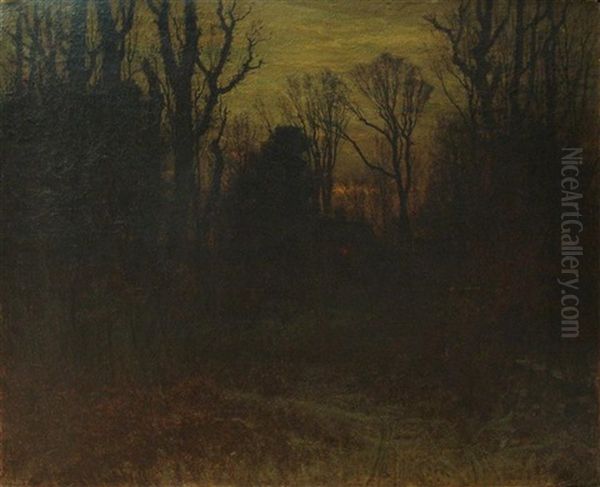
Today, John Joseph Enneking is recognized as a key figure in American Impressionism and late 19th-century landscape painting. His unique blend of Barbizon atmosphere, Tonalist mood, and Impressionist light and color distinguishes his work. He is praised for his technical skill, his sensitive rendering of the New England landscape, and his pioneering role in adapting Impressionist principles to an American context.
His paintings are held in the permanent collections of major museums, including the Museum of Fine Arts, Boston; the Worcester Art Museum; the Portland Museum of Art, Maine; the Currier Museum of Art in New Hampshire, and numerous other institutions and private collections. His work remains popular on the art market, consistently fetching strong prices at auction, indicating a sustained appreciation among collectors and art historians. Enneking's legacy endures through his evocative paintings, which continue to offer viewers a luminous and deeply felt connection to the natural beauty of New England.